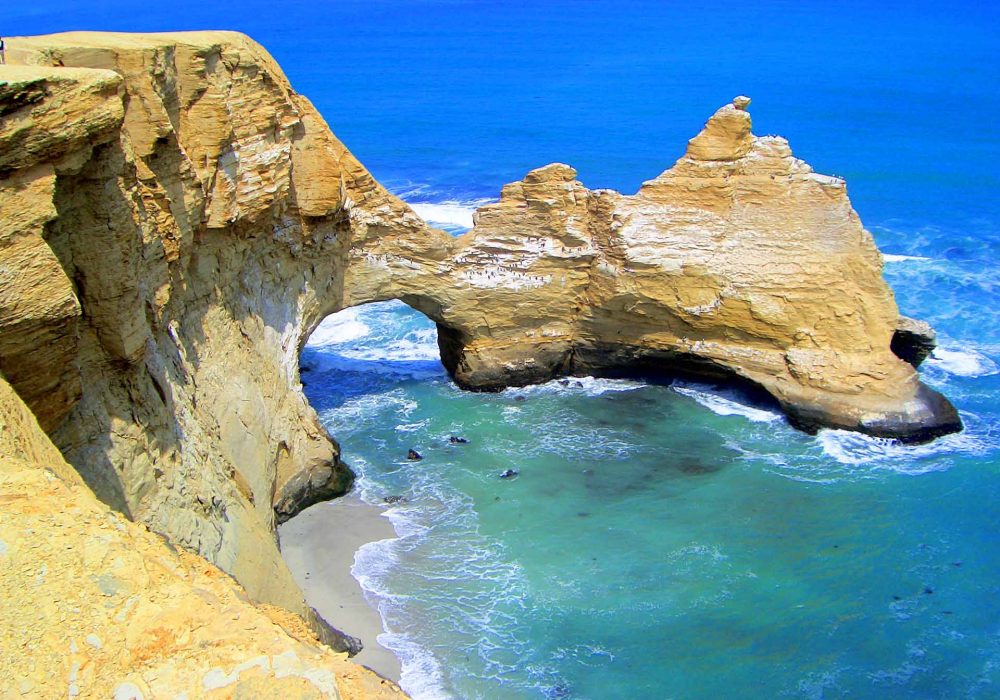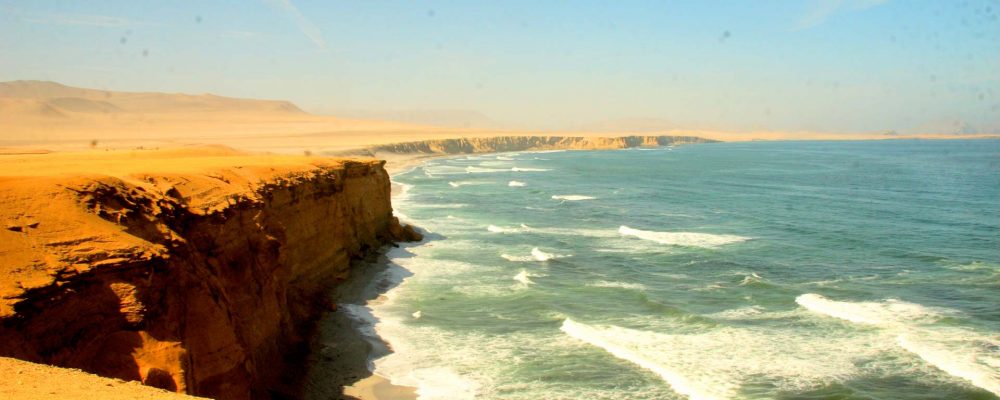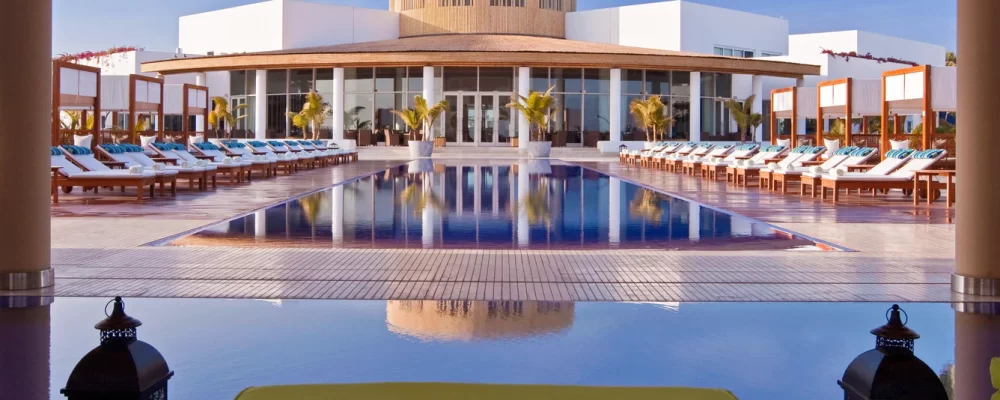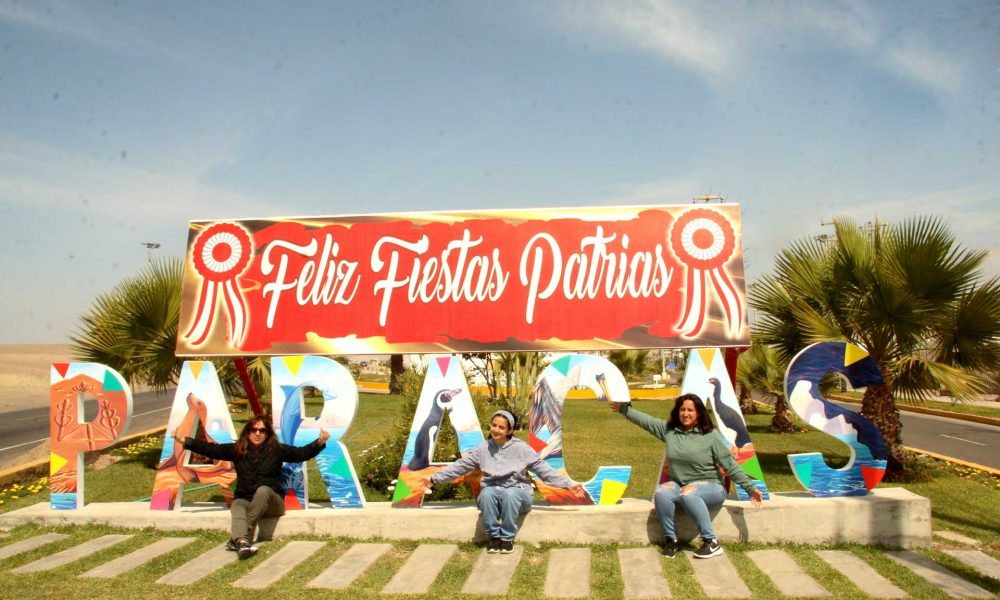Paracas
Paracas is a small but historically significant town located on the southern coast of Peru, known for its rich cultural heritage and stunning natural beauty. The region is particularly renowned for the Paracas National Reserve, a protected area established to preserve the unique ecosystem of the Paracas Peninsula and the adjacent marine environment. This coastal desert landscape is characterized by dramatic cliffs, red sand beaches, and the enigmatic Paracas Candelabra, a large prehistoric geoglyph etched into the hillside. Paracas is also celebrated for its archaeological treasures, including the ancient Paracas culture known for their intricate textiles and elaborate burial practices. The Paracas Museum exhibits a remarkable collection of artifacts and mummies, providing visitors with a glimpse into the fascinating history of this ancient civilization. Additionally, Paracas serves as a gateway to the Ballestas Islands, a group of uninhabited islands teeming with diverse marine life, making it a popular destination for nature enthusiasts and history buffs alike.

Table of Contents
Overview
Paracas is a historic and culturally rich region located on the southern coast of Peru, South America. Renowned for its archaeological significance, natural beauty, and vibrant culture, Paracas has become a popular destination for tourists and researchers alike.
Geography:
Paracas is situated in the Ica Region, approximately 260 kilometers (160 miles) south of Lima, the capital of Peru. The region is characterized by arid landscapes, expansive deserts, and stunning coastal views along the Pacific Ocean.
Paracas National Reserve:
One of the main attractions in Paracas is the Paracas National Reserve, a protected area established in 1975. This reserve is famous for its unique marine and desert ecosystems. Visitors can explore the otherworldly landscapes, observe diverse wildlife, and relax on pristine beaches.
Archaeological Importance:
Paracas is perhaps most renowned for the Paracas culture, an ancient pre-Inca civilization that thrived in the area around 800 BCE to 100 BCE. The Paracas people are particularly known for their intricate textiles and elaborate burial practices. The Paracas Candelabra, a large geoglyph etched into the hillside overlooking the Pacific, is another archaeological mystery that has captivated researchers and tourists alike.
Paracas Textiles:
The Paracas textiles are considered some of the finest and most sophisticated pre-Columbian textiles in the world. Intricately woven and brightly colored, these textiles often depict stylized animals and mythical creatures. Many of these artifacts can be seen in museums, both in Paracas and elsewhere in Peru.
Ballestas Islands:
The Ballestas Islands, also known as the “Little Galapagos,” are a group of small islands off the coast of Paracas. These islands are home to an incredible variety of marine life, including sea lions, penguins, and numerous seabird species. Boat tours to the Ballestas Islands offer a unique opportunity to observe these animals in their natural habitat.
Tourism:
Paracas has become a popular tourist destination, attracting nature enthusiasts, history buffs, and adventure seekers. The combination of archaeological sites, natural beauty, and outdoor activities makes it a well-rounded destination for those looking to explore both the cultural and natural wonders of Peru.
In summary, Paracas is a captivating destination that offers a blend of archaeological treasures, breathtaking landscapes, and unique wildlife experiences. Its rich history, particularly the legacy of the Paracas culture, makes it a fascinating place for those interested in delving into Peru’s ancient past.
History

Paracas is a region located on the southern coast of Peru, known for its rich history and archaeological significance. The history of Paracas is closely tied to the Paracas culture, which thrived in the area from around 800 BCE to 100 BCE.
Early Paracas Culture (800 BCE – 200 BCE):
The Paracas culture is divided into two phases: Paracas Cavernas (800 BCE – 300 BCE) and Paracas Necropolis (300 BCE – 100 BCE). The early Paracas people were skilled in agriculture, fishing, and weaving. They left behind intricate textiles, ceramics, and elaborate burials.
Textiles and Artifacts:
One of the most remarkable aspects of the Paracas culture is their intricate and finely woven textiles. The Paracas people used a variety of natural dyes and created complex patterns featuring animals, humans, and mythological creatures. These textiles were often used in burials, wrapped around the deceased as a form of elaborate funerary attire.
The Paracas Necropolis:
The later phase of the Paracas culture, known as Paracas Necropolis, is characterized by elaborate burials in large underground chambers. These burials contained not only textiles but also pottery, jewelry, and other grave goods. The Paracas Necropolis has provided valuable insights into the social structure, religious beliefs, and daily life of the Paracas people.
Cranial Deformation:
One distinctive feature of the Paracas culture is the practice of cranial deformation. The elite members of society, particularly children, had their skulls artificially shaped, resulting in elongated and cone-shaped heads. The reasons behind this practice are not fully understood, but it is believed to have held cultural and possibly social significance.
Decline of the Paracas Culture:
The decline of the Paracas culture around 100 BCE is not well-documented, and the reasons for their disappearance remain speculative. Some theories suggest environmental changes, social unrest, or conflicts with neighboring cultures may have played a role.
Rediscovery and Archaeological Investigations:
The Paracas culture remained largely unknown until the early 20th century when archaeologist Julio Tello made significant discoveries in the region. His excavations unearthed the well-preserved textiles and artifacts that have since become iconic representations of the Paracas culture.
Paracas National Reserve:
Today, the Paracas National Reserve, established in 1975, protects the archaeological sites and the unique coastal ecosystem. The reserve is home to diverse wildlife, including marine species, seabirds, and the elusive Humboldt penguin.
In summary, the history of Paracas is a fascinating journey into the ancient past of Peru, revealing a culture with advanced artistic skills, distinctive burial practices, and a complex societal structure that has left an enduring legacy in the form of remarkable artifacts and archaeological sites.
Things to do
Paracas, located on the southern coast of Peru, is a charming coastal town known for its natural beauty, wildlife, and outdoor activities. Here are some fantastic things to do in Paracas:
Paracas National Reserve:
Explore the breathtaking Paracas National Reserve, a protected area known for its stunning desert landscapes and coastal views. The reserve is home to diverse marine and birdlife, including flamingos, sea lions, and various seabird species. Take a guided tour to fully appreciate the beauty of this unique ecosystem.
Ballestas Islands Tour:
Embark on a boat tour to the Ballestas Islands, often referred to as the “Poor Man’s Galapagos.” These islands are a haven for wildlife enthusiasts, offering the chance to spot sea lions, penguins, and a variety of seabirds. Keep your camera ready for amazing photo opportunities.
Red Beach (Playa Roja):
Visit the Red Beach, named for its distinctive red sand. Relax on the shoreline, take a swim in the refreshing waters, and enjoy the unique scenery created by the contrast of the red sand against the blue sea.
El Candelabro:
Marvel at the mysterious geoglyph known as “El Candelabro,” a massive figure etched into the side of a hill overlooking the ocean. The origins and purpose of this ancient symbol remain a mystery, adding an air of intrigue to your visit.
Paracas History Museum:
Gain insights into the region’s history and cultural heritage by visiting the Paracas History Museum. The museum displays artifacts from the Paracas culture, providing a glimpse into the ancient civilizations that once thrived in the area.
Kite Surfing and Wind Sports:
Take advantage of the strong winds in Paracas by engaging in water sports like kite surfing and windsurfing. The bay’s conditions make it an ideal spot for both beginners and experienced enthusiasts.
Quad Biking and Sandboarding:
Experience the thrill of exploring the Paracas desert on a quad bike. Many tours offer a combination of quad biking and sandboarding, allowing you to ride over the dunes and try your hand at sliding down the sandy slopes.
Gastronomic Delights:
Indulge in fresh seafood at one of Paracas’ many restaurants along the waterfront. Try local specialties like ceviche, a popular dish made with raw fish cured in citrus juices and spiced with chili peppers.
Chandelier Hill:
Take a drive or hike up to Chandelier Hill for panoramic views of the surrounding landscape and the mysterious Nazca Lines. The hill provides an excellent vantage point for observing the immense desert and coastline.
Stargazing:
Enjoy the clear night skies of Paracas by stargazing on the beach. The lack of light pollution makes it an ideal location to observe constellations, planets, and the Milky Way.
Whether you’re interested in wildlife, outdoor adventures, or cultural experiences, Paracas offers a diverse range of activities for every type of traveler.
Activities
Paracas, located on the southern coast of Peru, is a stunning destination known for its natural beauty, diverse marine life, and rich cultural heritage. The region offers a wide range of activities that cater to nature lovers, adventure seekers, and history enthusiasts alike. Here are some notable activities you can enjoy in Paracas:
Paracas National Reserve:
Explore the Paracas National Reserve, a protected area known for its breathtaking landscapes and diverse ecosystems. The reserve is home to unique wildlife, including flamingos, sea lions, and various seabird species. Visitors can hike along the coastal cliffs and enjoy panoramic views of the Pacific Ocean.
Ballestas Islands Boat Tour:
Take a boat tour to the Ballestas Islands, often referred to as the “Poor Man’s Galapagos.” These islands are teeming with wildlife, including sea lions, penguins, and numerous seabirds. The boat ride also provides an opportunity to witness the famous Candelabro geoglyph, a mysterious figure etched into the sand dunes.
Water Sports:
Paracas Bay offers excellent conditions for water sports enthusiasts. Visitors can engage in activities such as kayaking, paddleboarding, and windsurfing. The calm waters and steady winds make it an ideal location for both beginners and experienced water sports enthusiasts.
Kite Surfing:
With its consistent winds, Paracas has become a popular destination for kite surfing. Several schools in the area offer lessons for beginners, and more experienced kite surfers can take advantage of the conditions for an exhilarating experience on the water.
Beach Relaxation:
Enjoy the pristine beaches of Paracas for a relaxing day under the sun. Red Beach (Playa Roja) and Lagunillas Beach are popular choices, offering soft sands and clear waters. These beaches are perfect for sunbathing, beachcombing, or simply taking in the coastal beauty.
Archaeological Sites:
Explore the rich cultural history of the region by visiting archaeological sites such as the Paracas Candelabra and the Julio C. Tello Museum. The Paracas Candelabra is a massive geoglyph etched into the side of a hill, while the museum showcases artifacts from the Paracas culture, including well-preserved textiles and pottery.
Gastronomic Experiences:
Indulge in the local culinary delights, especially fresh seafood. Numerous seafood restaurants in Paracas offer dishes featuring the day’s catch, providing visitors with a delicious taste of the region’s maritime bounty.
Paracas is a destination that seamlessly combines natural beauty, outdoor activities, and cultural exploration, making it a must-visit for travelers seeking a diverse and enriching experience.
Hotels

Paracas, located on the southwestern coast of Peru, is a picturesque destination known for its stunning landscapes, rich history, and vibrant marine life. The town is a gateway to the Paracas National Reserve, a protected area famous for its diverse ecosystems and the Ballestas Islands, often referred to as the “Poor Man’s Galapagos” due to its abundant wildlife.
In Paracas, visitors can find a variety of hotels that cater to different preferences and budgets, offering a comfortable stay amid the beauty of the surrounding environment. Here are some aspects to consider when exploring hotels in Paracas:
Luxury Resorts:
Hotel Paracas, a Luxury Collection Resort: This upscale resort is known for its luxurious amenities and breathtaking views of the ocean. It offers spacious rooms, fine dining restaurants, a spa, and outdoor pools. Guests can enjoy the tranquility of the surroundings while being pampered with top-notch services.
Mid-Range Options:
La Hacienda Bahia Paracas: This mid-range hotel combines comfort with affordability. It provides comfortable rooms, a swimming pool, and a restaurant serving local and international cuisine. The location is convenient for exploring the nearby attractions.
Boutique Hotels:
Hotel Emancipador: This boutique hotel offers a unique and personalized experience. With a smaller number of rooms, guests can expect attention to detail and a more intimate atmosphere. The hotel often features stylish décor and local touches.
Family-Friendly Accommodations:
DoubleTree Resort by Hilton Paracas: Known for its family-friendly atmosphere, this resort offers spacious rooms and a range of activities for both adults and children. The property often provides special amenities for families, such as a kids’ club and family-friendly dining options.
Hostels and Budget Options:
Kokopelli Hostel Paracas: For budget-conscious travelers, this hostel offers dormitory-style accommodation and private rooms at affordable rates. It’s a great option for backpackers looking for a social atmosphere and proximity to Paracas’ attractions.
Seaside Hotels:
Arpoador Paracas: Some hotels in Paracas are strategically located along the coastline, providing guests with stunning views of the ocean. Arpoador Paracas is an example, offering comfortable rooms with balconies overlooking the sea.
When choosing a hotel in Paracas, it’s essential to consider your preferences, budget, and the type of experience you’re seeking. Whether you opt for a luxurious resort, a boutique hotel, or a budget-friendly option, Paracas provides a range of accommodations to suit various tastes and needs, ensuring a memorable stay in this beautiful coastal town.
Restaurants
Paracas, a charming coastal town located on the southern coast of Peru, is not only known for its stunning landscapes but also for its diverse and delicious culinary scene. The restaurants in Paracas offer a mix of traditional Peruvian flavors, fresh seafood, and international cuisine, creating a delightful experience for visitors.
One of the highlights of dining in Paracas is the abundance of seafood options. Being situated along the Pacific Ocean, the town is a seafood lover’s paradise. Many restaurants source their ingredients directly from the local fishermen, ensuring the freshest catch of the day. Ceviche, a popular Peruvian dish, is a must-try in Paracas. Fresh fish, marinated in lime juice, mixed with onions, cilantro, and a touch of spice, creates a refreshing and flavorful dish that perfectly complements the coastal ambiance.
For those seeking a taste of traditional Peruvian cuisine, Paracas has numerous restaurants that showcase the country’s rich culinary heritage. Lomo Saltado, a stir-fry dish combining beef, vegetables, and Peruvian spices, is a favorite among locals and tourists alike. Additionally, you can savor the delicious and hearty Peruvian stews such as Aji de Gallina or Seco de Res.
While seafood and Peruvian specialties dominate the culinary scene, Paracas also offers international dining options. Visitors can find Italian, Mexican, and even Asian-inspired restaurants, catering to a diverse range of tastes. Some establishments even provide a fusion of Peruvian and international flavors, creating a unique culinary experience.
The ambiance of the restaurants in Paracas is as diverse as the cuisine. Many establishments boast picturesque views of the ocean, allowing patrons to enjoy their meals while taking in the breathtaking sunset or watching the waves crash along the shoreline. Others offer cozy interiors with vibrant decor, creating a welcoming atmosphere for diners.
Whether you’re a food enthusiast or someone looking to enjoy a relaxing meal by the sea, Paracas has a variety of restaurants to suit every palate. From the bold flavors of Peruvian classics to the freshest seafood, dining in Paracas is an integral part of experiencing the town’s rich culture and natural beauty.
Tour Packages
Travel Tips

Paracas, located on the southwestern coast of Peru, is a captivating destination known for its natural beauty, diverse wildlife, and rich cultural heritage. Here are some travel tips to make the most of your visit to Paracas:
Weather and Best Time to Visit:
Paracas has a desert climate, characterized by warm temperatures and minimal rainfall. The best time to visit is during the dry season from December to March when temperatures are comfortable. However, keep in mind that Paracas can be windy, so be prepared with layers and wind-resistant clothing.
Transportation:
The most common way to reach Paracas is by bus or private transportation from Lima, which is approximately a four-hour drive. Alternatively, you can take a flight to Pisco, which is the nearest airport, and then travel to Paracas. Once in Paracas, renting a bicycle or a scooter is a convenient way to explore the area.
National Reserve:
Don’t miss the Paracas National Reserve, a stunning natural reserve known for its red sand beaches, cliffs, and diverse marine life. Consider hiring a local guide to enhance your experience and learn more about the unique flora and fauna.
Ballestas Islands:
Take a boat tour to the Ballestas Islands, often referred to as the “Poor Man’s Galapagos.” These islands are home to a variety of seabirds, sea lions, and even penguins. The boat tours typically depart from the Paracas harbor and offer fantastic opportunities for wildlife observation.
Islas Chincha:
Consider exploring the nearby Islas Chincha, where you can learn about the Afro-Peruvian culture and history. The islands played a significant role in the slave trade during the colonial era, and there are remnants of the past that you can explore.
Culinary Delights:
Paracas is known for its fresh seafood, so be sure to indulge in local culinary delights. Try ceviche, a popular Peruvian dish made from raw fish cured in citrus juices, or sample other seafood dishes at the local restaurants along the waterfront.
Sunset Views:
Witness the breathtaking sunset over the Paracas Bay. The changing colors of the sky combined with the silhouette of the Ballestas Islands create a picturesque scene that shouldn’t be missed.
Protective Gear:
Due to the strong winds in the area, it’s advisable to bring a hat, sunglasses, and sunscreen to protect yourself from the sun. If you plan on exploring the dunes or taking a boat tour, consider wearing a windbreaker or lightweight jacket.
Accommodation:
Paracas offers a range of accommodation options, from upscale resorts to budget-friendly hostels. Book your accommodation in advance, especially during peak tourist seasons, to secure the best rates.
Responsible Tourism:
Respect the natural environment and wildlife during your visit. Follow designated trails, avoid disturbing wildlife, and adhere to responsible tourism practices to help preserve the beauty of Paracas for future generations.
By keeping these travel tips in mind, you can make the most of your visit to Paracas and immerse yourself in the natural wonders and cultural richness of this enchanting destination.
FAQ´s
Paracas is a beautiful coastal town located on the southern coast of Peru, approximately 260 kilometers (162 miles) south of Lima. It is renowned for its stunning natural landscapes, rich marine life, and archaeological significance.
The most common way to reach Paracas is by bus or private transportation from Lima. The journey takes around 3-4 hours, depending on traffic. Alternatively, there are domestic flights to Pisco, which is the nearest airport to Paracas.
The best time to visit Paracas is during the dry season, which typically spans from December to March. During this period, you can enjoy sunny weather and explore the natural beauty of the region without concerns about rain.
Paracas is renowned for the Paracas National Reserve, known for its stunning coastline, red sand beaches, and diverse wildlife. The Ballestas Islands, often referred to as the “Poor Man’s Galapagos,” are a must-visit for their abundant marine life, including sea lions, penguins, and various bird species.
Yes, there is an entrance fee to access the Paracas National Reserve. Fees may vary for locals and foreigners. It is advisable to check the latest information on entry fees before planning your visit.
Absolutely! Paracas offers a range of water activities, including boat tours to the Ballestas Islands, kayaking, and even windsurfing. The calm waters of Paracas Bay make it an ideal location for these activities.
It is recommended to pack sunscreen, a hat, comfortable clothing, and sturdy shoes for exploring the reserve. If you plan on engaging in water activities, bring a swimsuit and a light jacket. Don’t forget your camera to capture the breathtaking scenery.
Yes, Paracas offers a variety of accommodations ranging from budget-friendly hostels to luxury resorts. It is advisable to book your accommodation in advance, especially during peak tourist seasons.
Yes, many tour operators offer day trips from Lima to Paracas, allowing you to explore the main attractions and return to Lima in the evening. However, if time permits, consider spending a night to fully experience all that Paracas has to offer.
Paracas is generally considered safe for tourists. However, like any destination, it’s essential to take standard precautions, such as safeguarding your belongings and staying informed about local conditions.
Remember to check for any travel advisories or updates before planning your visit to ensure a smooth and enjoyable experience in Paracas.




